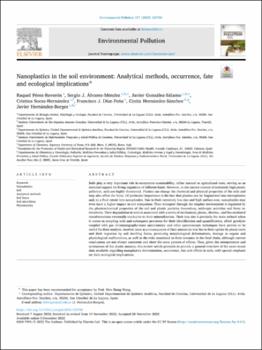Nanoplastics in the soil environment: Analytical methods, occurrence, fate and ecological implications
Date
2023Abstract
Soils play a very important role in ecosystems sustainability, either natural or agricultural ones, serving as an essential support for living organisms of different kinds. However, in the current context of extremely high plastic
pollution, soils are highly threatened. Plastics can change the chemical and physical properties of the soils and
may also affect the biota. Of particular importance is the fact that plastics can be fragmented into microplastics
and, to a final extent into nanoplastics. Due to their extremely low size and high surface area, nanoplastics may even have a higher impact in soil ecosystems. Their transport through the edaphic environment is regulated by the physicochemical properties of the soil and plastic particles themselves, anthropic activities and biota interactions. Their degradation in soils is associated with a series of mechanical, photo-, thermo-, and bio-mediated
transformations eventually conducive to their mineralisation. Their tiny size is precisely the main setback when it comes to sampling soils and subsequent processes for their identification and quantification, albeit pyrolysis coupled with gas chromatography-mass spectrometry and other spectroscopic techniques have proven to be useful for their analysis. Another issue as a consequence of their minuscule size lies in their uptake by plants roots and their ingestion by soil dwelling fauna, producing morphological deformations, damage to organs and physiological malfunctions, as well as the risks associated to their entrance in the food chain, although current conclusions are not always consistent and show the same pattern of effects. Thus, given the omnipresence and seriousness of the plastic menace, this review article pretends to provide a general overview of the most recent
data available regarding nanoplastics determination, occurrence, fate and effects in soils, with special emphasis
on their ecological implications.






